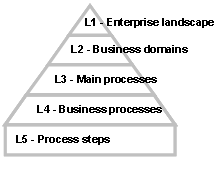| Activity: 2.2 Understand Current state process |
 |
|
| Description | Work Breakdown Structure | Roles | Work Product Usage | ||||||
The objective is to gain a clear understanding of the relevant current process activities, their intrinsic value, and the strengths and weaknesses of each key process in scope. Special focus is on the governance of the processes.
Each model consists of a number of processes, sub-processes, events and roles. Depending on the actual use of the
model, a number of attributes might have to be added to these items or there might be some additional requirements
about the structure of the process model. Also the level of detail is mainly determined by the purpose you have with
the model. In general at strategic level one is more interested in high level models and at operational level people
are interested in details: how things are done, by whom, with what, etc. |
| Parent Activities |
|---|
Make sure you use all the material that is available within the context of the clients goals and perspectives and is within the scope of the engagement. This step is, depending on the scope of your engagement, a very short (when things are clear and processes are in place) or a very extensive one (especially when new products / services are defined or when de client hasn’t made up his mind were exactly he wants to go) Usually (Business) Process Models are used as the way of representing the current (but also future) state processes. The models are developed for a specific purpose (depending on the aim of the assignment) such as:
The process architecture is divided into five levels. At the first level the overall value added chain of the
enterprise is considered. At the levels 2 and 3 the necessary breakdown into business domains and main processes is
performed, in order to be able to describe the business processes at level 4.
Level 5 details process activity, which is typically done in a work instruction. This fifth level is out of scope for
current state understanding.
Main issue here is that this content is a valuable for the current state as well as the futures state. Depending on the
scope of the engagement you spend more or less time on this issue. Most of the time these elements are given and you
are not allowed to spend lots of time identifying all these elements and are you asked to come for instance to
improvement suggestion. So be aware.
|
